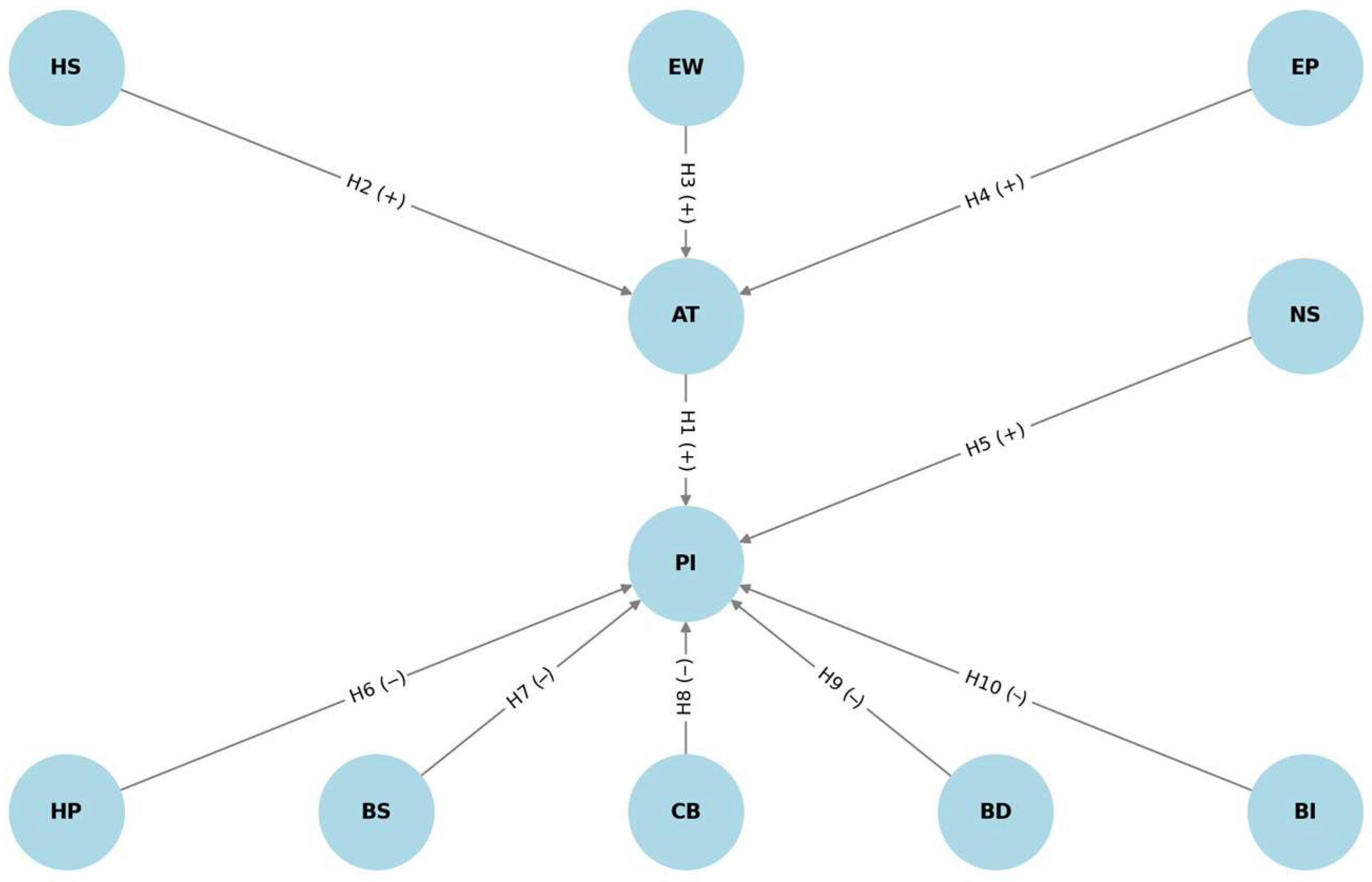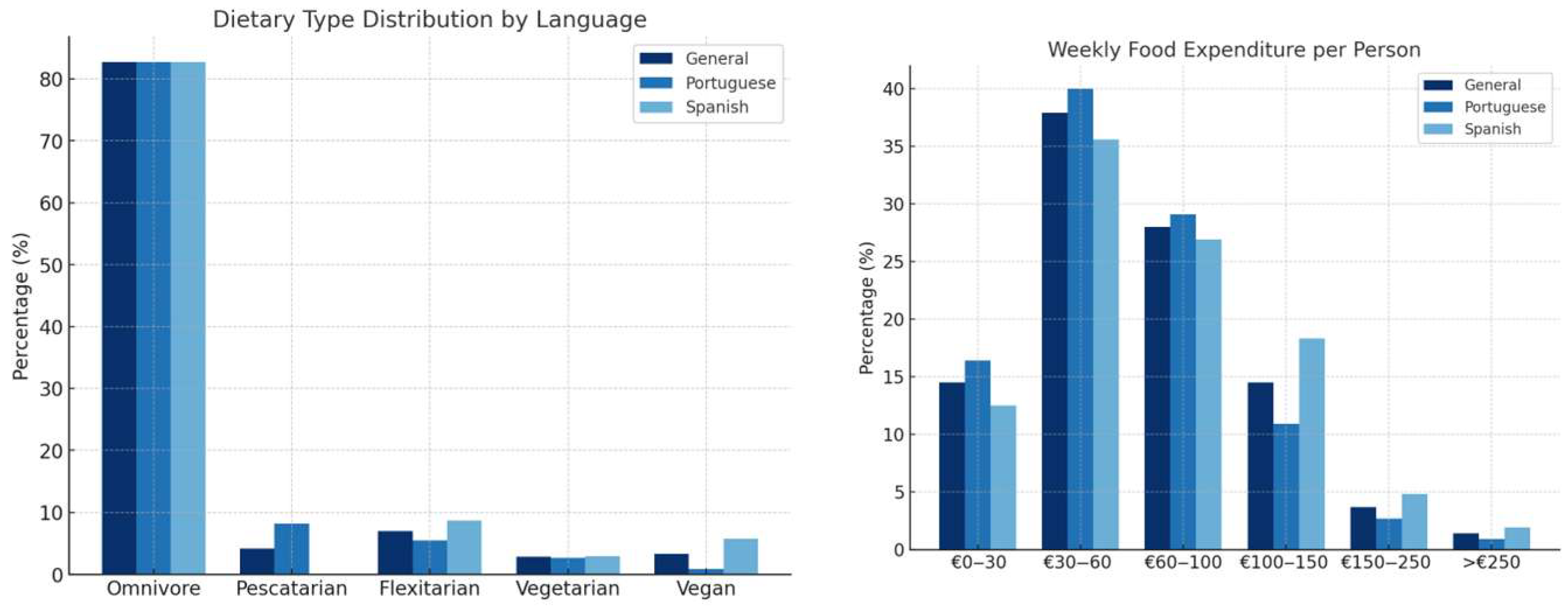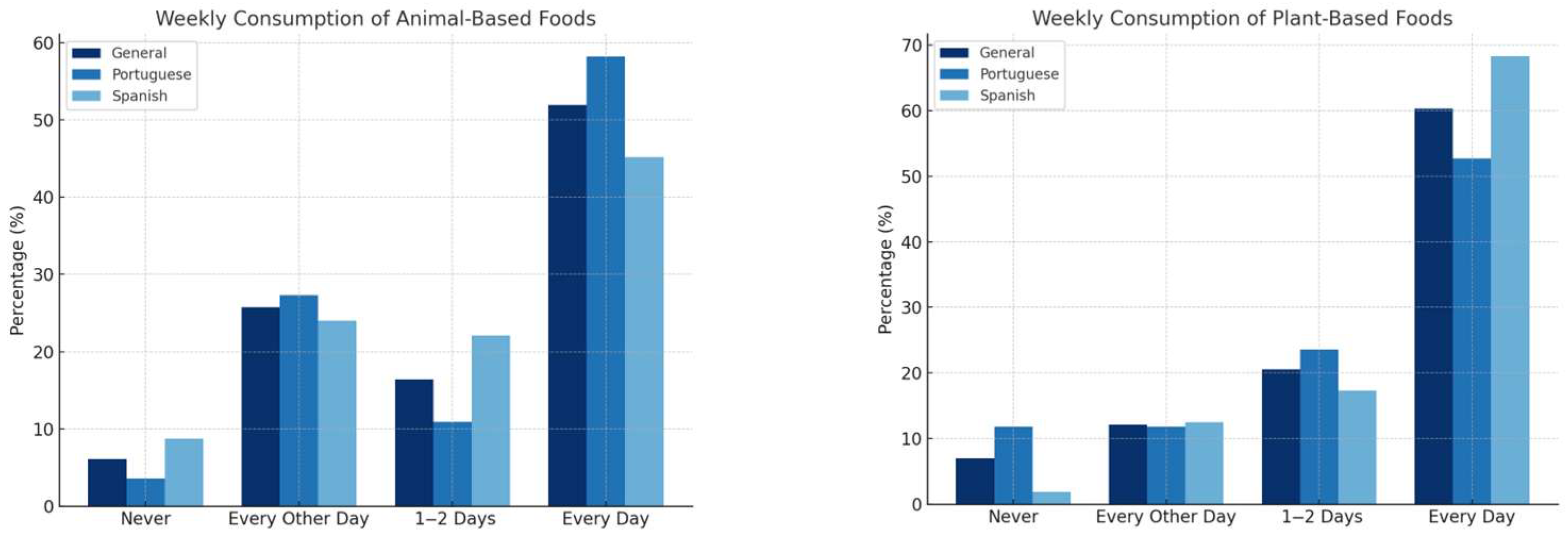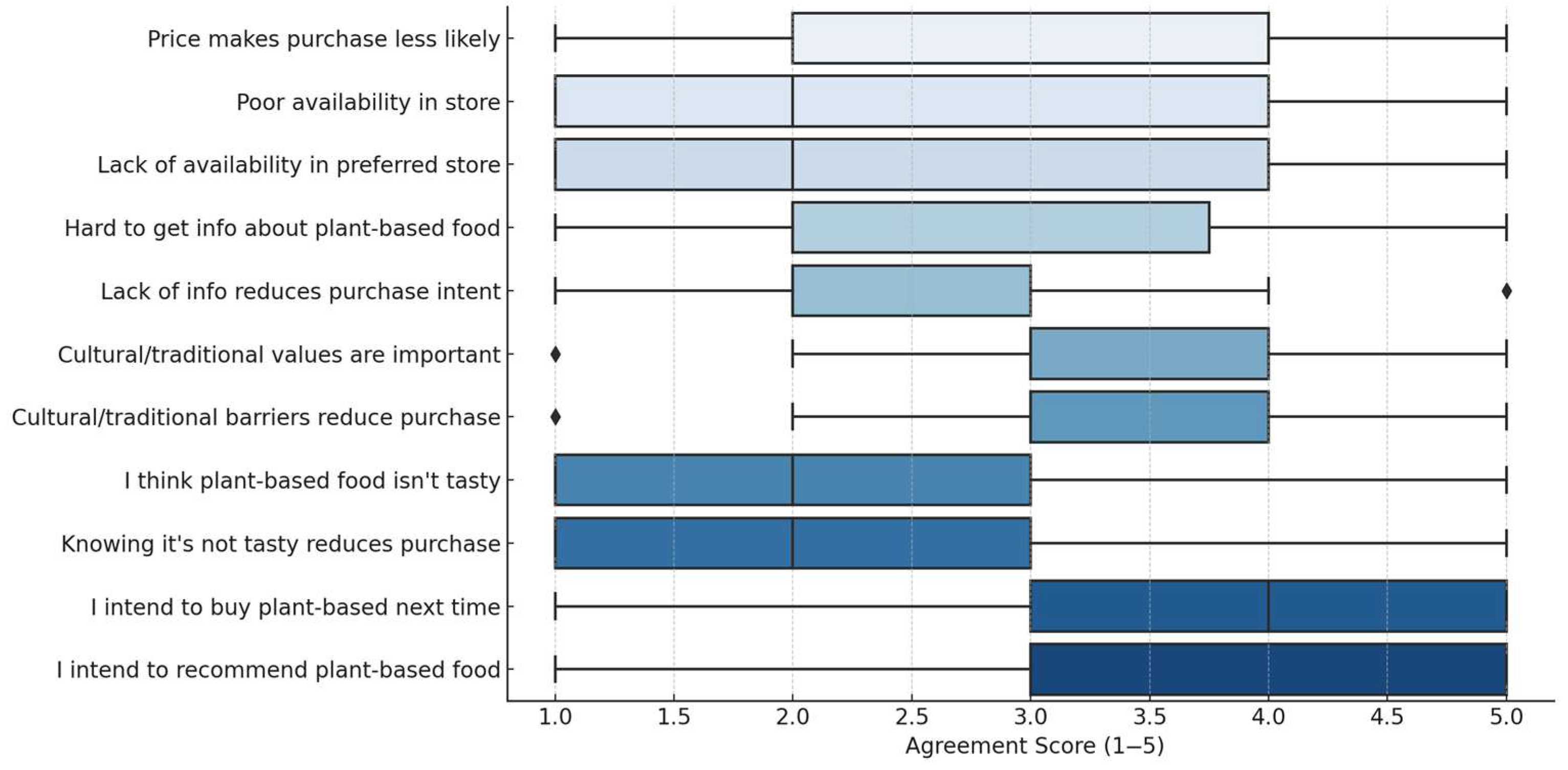From Values to Intentions: Drivers and Barriers of Plant-Based Food Consumption in a Cross-Border Context
Abstract
1. Introduction
2. Theoretical Background
2.1. Plant-Based Foods
2.2. Types of Consumers
2.3. Variables of Attitude Towards the Consumption of Plant-Based Foods
- -
- Variable Health Consciousness: Health consciousness is simply an individual’s concern for their own health (Teng & Lu, 2016). Health consciousness induces consumers to adhere to behaviors that improve or maintain their health (Wardle & Steptoe, 2003). According to some studies, it is possible to prove that a diet exclusively based on plant-based foods prevents many types of diseases (Lea & Worsley, 2001), and that consumers of plant-based foods usually have low cholesterol and blood pressure levels, which reduces the risk of cardiovascular diseases (Craig, 2009). In addition to the health evidence cited, other studies support that a diet made up of plant-based foods is healthier than a diet made up of foods of animal origin, with processed meats often containing toxins, carcinogens, antibiotics, and growth hormones (Springmann et al., 2016).
- -
- Variable Animal Welfare: According to data from the United Nations, it is estimated that by 2100, the world’s population will exceed 11 billion, which will lead to a significant increase in the demand for proteins. Consumers in general have a respect for animals and are concerned about their feelings and living conditions (Greenebaum, 2018). Concern for animal welfare and disapproval of the act of killing them for protein is the main reason for avoiding eating meat in the Western world (Lea & Worsley, 2001).
- -
- Environmental Concern: Environmental concern is related to awareness of environmental issues and effort and willingness to contribute to solving them (Cruz, 2017; Franzen & Vogl, 2013). Environmental concern refers to “the degree to which people are aware of environmental problems and support efforts to solve them and/or indicate a willingness to personally contribute to their resolution” (Dunlap & Jones, 2012). It has been proven that up to 73% of a person’s carbon footprint can be reduced by cutting meat and dairy products from the diet, which produces environmental benefits (McCabe et al., 2017; Willett et al., 2019). Consumers who care about the environment are more likely to opt for an environmentally friendly lifestyle (Konuk et al., 2015).
2.4. Theory of Reasoned Action (TRA)
3. Methods
3.1. The Instrument
3.2. The Methods
3.3. Procedures
3.4. Characterization of the Sample
4. Analysis and Discussion of the Results
4.1. Food Consumption Habits
4.2. Intention, Recommendation, and Barriers
4.3. Regression Analysis for the Hypothesis
4.4. Sociodemographic Effects on Intention and Perceived Barriers
4.5. Discussion
5. Conclusions and Implications
5.1. Practical Implications
5.2. Limitations and Future Research
Author Contributions
Funding
Institutional Review Board Statement
Informed Consent Statement
Data Availability Statement
Acknowledgments
Conflicts of Interest
References
- Ajzen, I. (1991). The theory of planned behavior. Organizational Behavior and Human Decision Processes, 50(2), 179–211. [Google Scholar] [CrossRef]
- Ajzen, I., & Fishbein, M. (1980). Understanding attitudes and predicting social behaviour. Prentice-Hall. [Google Scholar]
- Allès, B., Baudry, J., Méjean, C., Touvier, M., Péneau, S., Hercberg, S., & Kesse Guyot, E. (2017). Comparison of sociodemographic and nutritional characteristics between self-reported vegetarians, vegans, and meat-eaters from the nutrinet-santé study. Nutrients, 9, 1023. [Google Scholar] [CrossRef]
- Appleby, P. N., Thorogood, M., Mann, J. I., & Key, T. J. A. (1999). The oxford vegetarian study: An overview. The American Journal of Clinical Nutrition, 70(3), 525s–531s. [Google Scholar] [CrossRef] [PubMed]
- Bakhsh, A., Lee, S.-J., Lee, E.-Y., Hwang, Y.-H., & Joo, S.-T. (2021). Traditional plant-based meat alternatives, current, and future perspective: A review. Journal of Agriculture & Life Science, 55(1), 1–11. [Google Scholar] [CrossRef]
- Bausch, C. L., Milan, G. S., Graciola, A. P., Eberle, L., & Bebber, S. (2021). The COVID-19 pandemic and the changes in consumer habits and behavior. Revista Gestão e Desenvolvimento, 18(3), 3–25. [Google Scholar] [CrossRef]
- Beverland, M. B. (2014). Sustainable eating: Mainstreaming plant-based diets in developed economies. Journal of Macromarketing, 34(3), 369–382. [Google Scholar] [CrossRef]
- Cardoso, D., Sousa, B., Liberato, D., Liberato, P., Lopes, E., Gonçalves, F., & Figueira, V. (2023). Digital communication and the crisis management in hotel management: A perspective in the Euroregion North of Portugal and Galicia (ERNPG). Administrative Sciences, 13(8), 191. [Google Scholar] [CrossRef]
- Casas, R., Raidó-Quintana, B., Ruiz-León, A. M., Castro-Barquero, S., Bertomeu, I., Gonzalez-Juste, J., Campolier, M., & Estruch, R. (2022). Changes in Spanish lifestyle and dietary habits during the COVID-19 lockdown. European Journal of Nutrition, 61, 2417–2434. [Google Scholar] [CrossRef]
- Craig, A. D. (2009). How do you feel—Now? The anterior insula and human awareness. Nature Reviews Neuroscience, 10(1), 59–70. [Google Scholar] [CrossRef]
- Cruz, S. M. (2017). The relationships of political ideology and party affiliation with environmental concern: A meta-analysis. Journal of Environmental Psychology, 53, 81–91. [Google Scholar] [CrossRef]
- Di Pietro, L., Guglielmetti Mugion, R., & Renzi, M. F. (2018). Heritage and identity: Technology, values and visitor experiences. Journal of Heritage Tourism, 13(2), 97–103. [Google Scholar] [CrossRef]
- Dorce, L. C., da Silva, M. C., Mauad, J. R. C., de Faria Domingues, C. H., & Borges, J. A. R. (2021). Extending the theory of planned behavior to understand consumer purchase behavior for organic vegetables in Brazil: The role of perceived health benefits, perceived sustainability benefits and perceived price. Food Quality and Preference, 91, 104191. [Google Scholar] [CrossRef]
- Dunlap, R. E., & Jones, R. E. (2012). Environmental concern: Conceptual and measurement issues. In R. E. Dunlap, & A. M. Michelson (Eds.), Handbook of environmental sociology (Vol. 3, pp. 482–524). Greenwood Press. [Google Scholar]
- Fardet, A. (2017). New concepts and paradigms for the protective effects of plant based food components in relation to food complexity. In Vegetarian and plant based diets in health and disease prevention (pp. 293–312). Academic Press. [Google Scholar] [CrossRef]
- Fehér, A., Gazdecki, M., Véha, M., Szakály, M., & Szakály, Z. (2020). A comprehensive review of the benefits of and the barriers to the switch to a plant-based diet. Sustainability, 12, 4136. [Google Scholar] [CrossRef]
- Fishbein, M. (1963). An investigation of the relationships between beliefs about an object and the attitude toward that object. Human Relations, 16(3), 233–239. [Google Scholar] [CrossRef]
- Fonseca, J. J. S. (2002). Apostilha de metodologia da pesquisa científica. Universidade Estadual do Ceará. [Google Scholar]
- Franzen, A., & Vogl, D. (2013). Two decades of measuring environmental attitudes: A comparative analysis of 33 countries. Global Environmental Change, 23(5), 1001–1008. [Google Scholar] [CrossRef]
- Freeland-Graves, J. H., Greninger, S. A., Vickers, J., Bradley, C. L., & Young, R. K. (1982). Nutrition knowledge of vegetarians and nonvegetarians. Journal of Nutrition Education, 14(1), 21–26. [Google Scholar] [CrossRef]
- Gebhardt, B. (2021). Plant-based for the future. Insights on European consumer and expert opinions. EIT Food, University of Hohenheim. [Google Scholar] [CrossRef]
- Giacalone, D., Clausen, M. P., & Jaeger, S. R. (2022). Understanding barriers to consumption of plant-based foods and beverages: Insights from sensory and consumer science. Current Opinion in Food Science, 48, 100919. [Google Scholar] [CrossRef]
- Graça, J., Oliveira, A., & Calheiros, M. M. (2015). Meat, beyond the plate. Data driven hypotheses for understanding consumer willingness to adopt a more plant-based diet. Appetite, 90, 80–90. [Google Scholar] [CrossRef]
- Graham, B. (2014). Edible identities: Food as cultural heritage. Ashgate Publishing, Ltd. [Google Scholar]
- Grasso, N., Roos, Y. H., Crowley, S. v., Arendt, E. K., & O’Mahony, J. A. (2021). Composition and physicochemical properties of commercial plant-based block style products as alternatives to cheese. Future Foods, 4, 100048. [Google Scholar] [CrossRef]
- Greenebaum, J. (2018). Vegans of color: Managing visible and invisible stigmas. Food, Culture & Society, 21(5), 680–697. [Google Scholar] [CrossRef]
- Hair, J. F., Sarstedt, M., Pieper, T. M., & Ringle, C. M. (2012). The use of partial least squares structural equation modeling in strategic management research: A review of past practices and recommendations for future applications. Long Range Planning, 45(5–6), 320–340. [Google Scholar] [CrossRef]
- Harris, J., de Steenhuijsen Piters, B., McMullin, S., Bajwa, B., de Jager, I., & Brouwer, I. D. (2023). Fruits and vegetables for healthy diets: Priorities for food system research and action. In Science and innovations for food systems transformation (Vol. 87). Springer. [Google Scholar]
- Hopwood, C. J., Bleidorn, W., Schwaba, T., & Chen, S. (2020). Health, environmental, and animal rights motives for vegetarian eating. PLoS ONE, 15(4), e0230609. [Google Scholar] [CrossRef] [PubMed]
- Jensen, K. (2020). The future of nutrition and food security. In Building the future of food safety technology. Academic Press. [Google Scholar] [CrossRef]
- Kapelari, S., Alexopoulos, G., Moussouri, T., Sagmeister, K. J., & Stampfer, F. (2020). Food heritage makes a difference: The importance of cultural knowledge for improving education for sustainable food choices. Sustainability, 12(4), 1509. [Google Scholar] [CrossRef]
- Katz, D. (1960). The functional approach to the study of attitudes. Public Opinion Quarterly, 24(2), 163–204. [Google Scholar] [CrossRef]
- Key, T. J., Appleby, P. N., & Rosell, M. S. (2006). Health effects of vegetarian and vegan diets. Proceedings of the Nutrition Society, 65(1), 35–41. [Google Scholar] [CrossRef]
- Konuk, F. A., Rahman, S. U., & Salo, J. (2015). Antecedents of green behavioral intentions: A cross-country study of Turkey, Finland and Pakistan. International Journal of Consumer Studies, 39(6), 586–596. [Google Scholar] [CrossRef]
- Lea, E., & Worsley, T. (2001). Influences on meat consumption in Australia. Appetite, 36(2), 127–136. [Google Scholar] [CrossRef]
- Lorenzo, P. M., Izquierdo, A. G., Rodriguez-Carnero, G., Fernández-Pombo, A., Iglesias, A., Carreira, M. C., Tejera, C., Bellido, D., Martinez-Olmos, M. A., Leis, R., Casanueva, F. F., & Crujeiras, A. B. (2022). Epigenetic effects of healthy foods and lifestyle habits from the southern European Atlantic diet pattern: A narrative review. Advances in Nutrition, 13(5), 1725–1747. [Google Scholar] [CrossRef]
- Malila, R. M., Pennanen, K., & Luomala, H. T. (2025). Meat alternative consumers still frowned upon in Europe: Analysis of stereotypical, emotional and behavioral responses of observing others. Food Quality and Preference, 125, 105380. [Google Scholar] [CrossRef]
- McCabe, S. E., West, B. T., Veliz, P., McCabe, V. V., Stoddard, S. A., & Boyd, C. J. (2017). Trends in medical and nonmedical use of prescription opioids among US adolescents: 1976–2015. Pediatrics, 139(4), e20162387. [Google Scholar] [CrossRef]
- Mick, D. G., Broniarczyk, S. M., & Haidt, J. (2004). Choose, choose, choose, choose, choose, choose, choose: Emerging and prospective research on the deleterious effects of living in consumer hyperchoice. Journal of Business Ethics, 52, 207–211. [Google Scholar] [CrossRef]
- Mousel, T., & Tang, X. (2016). Analysis of consumer behavior towards plant-based meat and dairy alternatives market in Sweden. Uppsala Universitet. [Google Scholar]
- Myresten, E., Setterhall, M., & Sörhammar, D. (2015). Theory of reasoned action and the role of external factors in organic food purchase. Uppsala Univesity. [Google Scholar]
- Newhouse, N. (2010). Implications of attitude and behavior research for environmental conservation. The Journal of Environmental Education, 22(1), 26–32. [Google Scholar] [CrossRef]
- Ngugi, I., O’Sullivan, H., & Osman, H. (2020). Consumer behaviour in food and healthy lifestyles. CABI. [Google Scholar]
- Petrovici, D. A., Ritson, C., & Ness, M. (2008). The theory of reasoned action and food choice. Journal of International Food & Agribusiness Marketing, 16(1), 59–87. [Google Scholar] [CrossRef]
- ProVeg International. (2022). Alimentos de origen vegetal en España. Conocimiento del mercado y del consumidor. Basado en la investigación del proyecto Smart Protein, un programa de investigación e innovación dentro de Horizonte 2020 de la Unión Europea (n.º 862957). Report, ProVeg, Spain. Available online: https://corporate.proveg.com/wp-content/uploads/2022/05/Report-Plant-based-food-in-Spain.pdf (accessed on 23 June 2023).
- Reipurth, M. F., Hørby, L., Gregersen, C. G., Bonke, A., & Cueto, F. J. P. (2019). Barriers and facilitators towards adopting a more plant-based diet in a sample of Danish consumers. Food Quality and Preference, 73, 288–292. [Google Scholar] [CrossRef]
- Ribeiro, M. J. D. J. P. (2023). Atitude do consumidor do Norte de Portugal e Galiza face ao consumo de alimentos de base vegetal e consequente intenção de compra [Master’s thesis, Instituto Politécnico de Viana do Castelo, Portugal]. [Google Scholar]
- Rickerby, A., & Green, R. (2024). Barriers to adopting a plant-based diet in high-income countries: A systematic review. Nutrients, 16(6), 823. [Google Scholar] [CrossRef] [PubMed]
- Rosenfeld, D. L., & Burrow, A. L. (2017). Vegetarian on purpose: Understanding the motivations of plant-based dieters. Appetite, 116, 456–463. [Google Scholar] [CrossRef] [PubMed]
- Röös, E., de Groote, A., & Stephan, A. (2022). Meat tastes good, legumes are healthy and meat substitutes are still strange—The practice of protein consumption among Swedish consumers. Appetite, 174, 106002. [Google Scholar] [CrossRef]
- Sachdeva, S., Sachdev, T. R., & Sachdeva, R. (2013). Increasing fruit and vegetable consumption: Challenges and opportunities. Indian Journal of Community Medicine, 38(4), 192–197. [Google Scholar] [CrossRef] [PubMed]
- Saunders, M., Lewis, P., & Thornhill, A. (2009). Research methods for business students. Pearson education. [Google Scholar]
- Schlosser, A. E. (1998). Applying the functional theory of attitudes to understanding the influence of store atmosphere on store inferences. Journal of Consumer Psychology, 7(4), 345–369. [Google Scholar] [CrossRef]
- Scholz, R. W., Bartelsman, E. J., Diefenbach, S., Franke, L., Grunwald, A., Helbing, D., Hill, R., Hilty, L., Höjer, M., Klauser, S., Montag, C., Parycek, P., Prote, J. P., Renn, O., Reichel, A., Schuh, G., Steiner, G., & Viale Pereira, G. (2018). Unintended side effects of the digital transition: European scientists’ messages from a proposition-based expert round table. Sustainability, 10(6), 2001. [Google Scholar] [CrossRef]
- Sheeran, P., & Webb, T. L. (2016). The intention–behavior gap. Social and Personality Psychology Compass, 10(9), 503–518. [Google Scholar] [CrossRef]
- Sheth, J. (2020). Impact of COVID-19 on consumer behavior: Will the old habits return or die? Journal of Business Research, 117, 280–283. [Google Scholar] [CrossRef] [PubMed]
- Solomon, M. R. (2010). Consumer behaviour: A European perspective. Pearson Education. [Google Scholar]
- Solomon, M. R. (2020). Consumer behavior: Buying, having, and being. Pearson. [Google Scholar]
- Springmann, M., Godfray, H. C. J., Rayner, M., & Scarborough, P. (2016). Analysis and valuation of the health and climate change cobenefits of dietary change. Proceedings of the National Academy of Sciences of the United States of America, 113(15), 4146–4151. [Google Scholar] [CrossRef] [PubMed]
- Teng, C. C., & Lu, C. H. (2016). Organic food consumption in Taiwan: Motives, involvement, and purchase intention under the moderating role of uncertainty. Appetite, 105, 95–105. [Google Scholar] [CrossRef]
- Tuso, P. J., Ismail, M., Ha, B. P., & Bartolotto, C. (2013). Nutritional update for physicians: Plant-based diets. The Permanente Journal, 17(2), 61–66. [Google Scholar] [CrossRef]
- Viroli, G., Kalmpourtzidou, A., & Cena, H. (2023). Exploring benefits and barriers of plant-based diets: Health, environmental impact, food accessibility and acceptability. Nutrients, 15(22), 4723. [Google Scholar] [CrossRef]
- Wansink, B., Sonka, S. T., Goldsmith, P., Chiriboga, J. M., & Nilgrün, E. (2005). Increasing the acceptance of soy-based foods. Journal of International Food & Agribusiness Marketing, 17(1), 35–55. [Google Scholar] [CrossRef]
- Wardle, J., & Steptoe, A. (2003). Socioeconomic differences in attitudes and beliefs about healthy lifestyles. Journal of Epidemiology & Community Health, 57(6), 440–443. [Google Scholar] [CrossRef]
- Willett, W., Rockström, J., Loken, B., Springmann, M., Lang, T., Vermeulen, S., Garnett, T., Tilman, D., DeClerck, F., Wood, A., Jonell, M., Clark, M., Gordon, L. J., Fanzo, J., Hawkes, C., Zurayk, R., Rivera, J. A., de Vries, W., Majele Sibanda, L., … Murray, C. J. L. (2019). Food in the anthropocene: The EAT lancet commission on healthy diets from sustainable food systems. The Lancet, 393(10170), 447–492. [Google Scholar] [CrossRef]
- Zwanka, R. J., & Buff, C. (2020). COVID-19 generation: A conceptual framework of the consumer behavioral shifts to be caused by the COVID-19 pandemic. Journal of International Consumer Marketing, 33(1), 58–67. [Google Scholar] [CrossRef]




| Construct | Item | Scale | Reference |
|---|---|---|---|
| Health Consciousness (HC) | I try to avoid foods that are unhealthy. I am concerned about the nutritional value of the food I eat. I prefer natural and organic foods. | 5-point Likert (1 = Strongly disagree, 5 = Strongly agree) | (Teng & Lu, 2016; Lea & Worsley, 2001) |
| Animal Welfare (AW) | I care about the treatment of animals used for food. I avoid foods that involve animal suffering. | 5-point Likert | (Hopwood et al., 2020; Rosenfeld & Burrow, 2017) |
| Environmental Concern (EC) | My food choices are influenced by environmental impact. I try to eat in ways that are environmentally sustainable. | 5-point Likert | (Dunlap & Jones, 2012; Willett et al., 2019) |
| Attitude towards Plant-Based Foods (AT) | I believe eating plant-based foods is a good choice. I have a positive perception of plant-based diets. | 5-point Likert | (Ajzen & Fishbein, 1980; Solomon, 2020) |
| Subjective Norm (SN) | My friends think I should eat more plant-based foods. People important to me support plant-based eating. | 5-point Likert | (Myresten et al., 2015; Mousel & Tang, 2016) |
| Purchase Intention (PI) | I intend to buy plant-based foods more often. I will likely choose plant-based products in the future. | 5-point Likert | (Petrovici et al., 2008; Beverland, 2014) |
| Barriers—High Price (HP) | Plant-based foods are too expensive. | 5-point Likert | (Fehér et al., 2020; Röös et al., 2022) |
| Barriers—Lack of Taste (LT) | Plant-based foods do not taste good. | 5-point Likert | (Giacalone et al., 2022; Reipurth et al., 2019) |
| Barriers—Cultural Barriers (CB) | Plant-based diets are not part of my food culture. | 5-point Likert | (Röös et al., 2022; Graça et al., 2015) |
| Barriers—Low Availability (LA) | It is hard to find plant-based options where I shop. | 5-point Likert | (Gebhardt, 2021) |
| Barriers—Lack of Information (LI) | I do not know enough about plant-based diets to follow one. | 5-point Likert | (Giacalone et al., 2022; Freeland-Graves et al., 1982) |
| Category | Gender | Age | |||||||
|---|---|---|---|---|---|---|---|---|---|
| Female | Male | Other | 17–20 | 21–25 | 26–30 | 31–40 | 41–60 | 60+ | |
| Total (%) | 69.6% | 29.9% | 0.5% | 0.5% | 4.7% | 7.0% | 18.2% | 65.4% | 4.2% |
| PT (%) | 67.3% | 32.7% | 0.0% | 0.0% | 9.1% | 9.1% | 16.4% | 61.8% | 3.6% |
| ES (%) | 72.1% | 26.9% | 1.0% | 1.0% | 0.0% | 4.8% | 20.2% | 69.2% | 4.8% |
| Employment Status | Educational Qualifications | |||||||||||||
|---|---|---|---|---|---|---|---|---|---|---|---|---|---|---|
| Unemployed | Domestic Worker | Employed (by Others) | Self-Employed | Student | Retired | Student Worker | Primary and 2nd Cycles | Mandatory Education | Secondary Education | Bachelor’s Degree | Postgraduate Degree | Master’s Degree | Doctorate | |
| Total (%) | 3.7% | 1.4% | 61.7% | 23.4% | 1.4% | 2.3% | 6.1% | 2.3% | 6.1% | 20.1% | 35.5% | 16.8% | 14.5% | 4.7% |
| PT (%) | 4.5% | 0.0% | 60.9% | 23.6% | 1.8% | 0.9% | 8.2% | 0.0% | 0.0% | 14.5% | 40.9% | 13.6% | 23.6% | 7.3% |
| ES (%) | 2.9% | 2.9% | 62.5% | 23.1% | 1.0% | 3.8% | 3.8% | 4.8% | 12.5% | 26.0% | 29.8% | 20.2% | 4.8% | 1.9% |
| Monthly Income | Household Composition | |||||||||
|---|---|---|---|---|---|---|---|---|---|---|
| <EUR 500 | EUR 501–EUR 900 | EUR 901–EUR 1200 | EUR 1201–EUR 1500 | >EUR 1500 | With Parents | Living Alone | With Colleagues | Couple Without Children | Couple With Children | |
| Total (%) | 3.7% | 17.6% | 20.1% | 22.1% | 36.5% | 9.3% | 11.2% | 0.9% | 17.8% | 60.7% |
| PT (%) | 4.5% | 17.3% | 21.8% | 20.9% | 35.5% | 14.5% | 10.0% | 0.0% | 16.4% | 59.1% |
| ES (%) | 2.9% | 18.3% | 18.3% | 23.1% | 37.5% | 3.8% | 12.5% | 1.9% | 19.2% | 62.5% |
| Hypothesis | Dependent | Independent | Coefficient | p-Value | |
|---|---|---|---|---|---|
| H1 | PI | AT | 0.350 | 0.0000 | Attitude towards consumption positively influences purchase intention |
| H2 | AT | HS | 0.713 | 0.0000 | Health consciousness positively influences attitude |
| H3 | AT | EW | 0.686 | 0.0000 | Animal welfare positively influences attitude |
| H4 | AT | EP | 0.736 | 0.0000 | Environmental concern positively influences attitude |
| H5 | PI | NS | 0.160 | 0.0153 | Subjective norm positively influences purchase intention |
| H6 | PI | HP | 0.011 | 0.8311 | High price negatively influences purchase intention |
| H7 | PI | BS | −0.315 | 0.0000 | Lack of taste negatively influences purchase intention |
| H8 | PI | CB | 0.312 | 0.0000 | Cultural aspects negatively influence purchase intention |
| H9 | PI | BD | −0.051 | 0.3072 | Poor availability negatively influences purchase intention |
| H10 | PI | BI | −0.126 | 0.0141 | Lack of information negatively influences purchase intention |
Disclaimer/Publisher’s Note: The statements, opinions and data contained in all publications are solely those of the individual author(s) and contributor(s) and not of MDPI and/or the editor(s). MDPI and/or the editor(s) disclaim responsibility for any injury to people or property resulting from any ideas, methods, instructions or products referred to in the content. |
© 2025 by the authors. Licensee MDPI, Basel, Switzerland. This article is an open access article distributed under the terms and conditions of the Creative Commons Attribution (CC BY) license (https://creativecommons.org/licenses/by/4.0/).
Share and Cite
da Fonseca, M.J.S.; Rodrigues, H.S.; Sousa, B.B.; Ribeiro, M.P. From Values to Intentions: Drivers and Barriers of Plant-Based Food Consumption in a Cross-Border Context. Adm. Sci. 2025, 15, 280. https://doi.org/10.3390/admsci15070280
da Fonseca MJS, Rodrigues HS, Sousa BB, Ribeiro MP. From Values to Intentions: Drivers and Barriers of Plant-Based Food Consumption in a Cross-Border Context. Administrative Sciences. 2025; 15(7):280. https://doi.org/10.3390/admsci15070280
Chicago/Turabian Styleda Fonseca, Manuel José Serra, Helena Sofia Rodrigues, Bruno Barbosa Sousa, and Mário Pinto Ribeiro. 2025. "From Values to Intentions: Drivers and Barriers of Plant-Based Food Consumption in a Cross-Border Context" Administrative Sciences 15, no. 7: 280. https://doi.org/10.3390/admsci15070280
APA Styleda Fonseca, M. J. S., Rodrigues, H. S., Sousa, B. B., & Ribeiro, M. P. (2025). From Values to Intentions: Drivers and Barriers of Plant-Based Food Consumption in a Cross-Border Context. Administrative Sciences, 15(7), 280. https://doi.org/10.3390/admsci15070280







